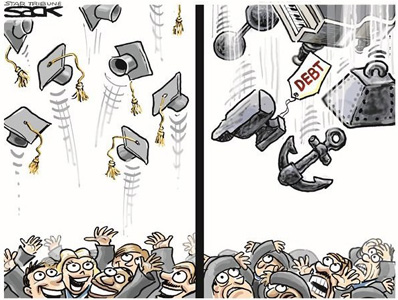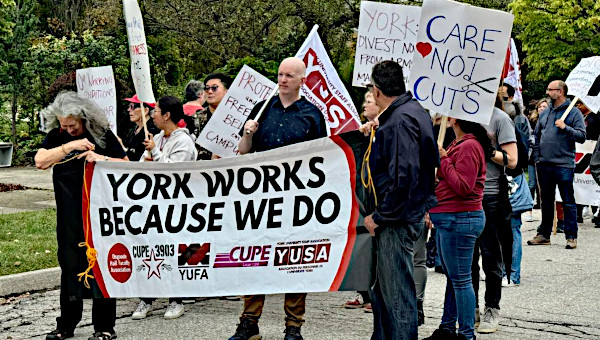The Bipartisan Assault on Higher Education
Barack Obama and Republican Party Presidential nominee Mitt Romney agree that the Stafford loan program should be maintained at a 3.4 per cent interest rate, rather than being allowed to double by this July. This, somehow, is seen as a great boon to students and evidence of a bipartisan commitment to the upcoming generation. Keeping interest rates low purportedly encourages prospective students to choose more education than they might otherwise aspire to, to select more expensive colleges than they could otherwise seek, and to finance this education through more debt than they would otherwise incur. The first is undoubtedly socially progressive.

Taken together, however, this is a social train wreck, and not least for the left. The university as an institution has always been embedded in the larger society. It was always in the business of imbuing its pupils, in part, with a regimented curriculum reflecting to one degree or another the retrograde values of the existing social order. But the structure of student aid further corrupts the experience of education in more visceral ways. Student debt is not dischargeable in bankruptcy, an issue that is particularly painful in times of high unemployment. Therefore, saddling students with high debts at the beginning of work condemns them to a life of debt peonage. It relentlessly produces a more skilled labour force but drives that herd inexorably into the most lucrative, rather than the most socially useful, avenues of employment. It devalues even the minimal critical faculties of independent thought and creativity cultivated by a liberal education, thereby ever transforming the university system into a wholly-functioning capitalist subsidiary.
It forces students, on pain of ruin, to leverage their accumulating financial liabilities into productive assets for capital. It redirects mountains of engineering students, mathematicians and physicists into finance, where creativity is expended self-servingly on fermenting novel means of hoovering income up the class pipeline. And in the end, it contributes ever less to the productive capacity or cultural enrichment of society that a radical movement could later liberate and socialize for the general betterment of humanity.
“The central contradiction of student life boils down to this. Students come to the university with the goal of leading humanly meaningful lives only to find themselves being programmed to be useful to capital.”
The central contradiction of student life boils down to this. Students come to the university with the goal of leading humanly meaningful lives only to find themselves being programmed to be useful to capital. Students may well have realized they are being trained to prop up a decaying social order, but find themselves ever more powerless to resist it. The system of student aid, as it is presently constituted, chains them to the mentality of acquisitiveness, of competitiveness, to the celebration of inequality and habits of submission and conformity that enhance the prospects for employment needed to discharge debt.
Rationalizing Debt
The Helpful Hannahs and Henrys of the Democratic Party do not, of course, question the desirability of this dynamic, but merely seek to rationalize it. Keeping interest rates relatively low is just one aspect of this. Senator Ron Wyden, for instance, recently introduced a bill that would have the government disseminate statistics about graduation rates, incomes, and debt levels so that students can better evaluate how their particular program of study measures up to the debt that they assume in pursuit of their degrees. New York Times columnist Frank Bruni would go even further, calling for “government and university incentives to steer students into fields of study that will serve them and society best. We use taxes to influence behavior,” he observes. “Why not student aid?”
But system efficiency is now largely beside the point. The acute crisis of capitalism has thrown a wrench into the machinery of higher education. Students faced with the prospects of protracted unemployment, who – as they often say – have done ‘everything right,’ now find themselves increasingly unable to assimilate norms that are so widely at variance with their actual social existence. They feel instinctively uneasy even though they have yet no clearly defined ideas of what is wrong with society, nor what an alternative and more fully human society could look like. The debts remain. But now they are coupled with a poisonous atmosphere of desperation, malaise and self-estrangement that together drive the impetus of the Occupy movement. Students find themselves ever more unable to identify their futures with the existing social system.
This sense of resistance, no longer one of free-floating alienation that characterized student life in more prosperous times, means that their social opposition is also no longer abstract. It has pressing and concrete aspirations. This pulls the Occupy movement in two contradictory directions: an ambitious, but still amorphous desire to create alternative social structures that compete with existing institutions combined with explicit political demands on the state and the capitalist class that controls that state for redress of immediate grievances. To the extent that it is countercultural it tends toward the apolitical but to the extent that it also formulates demands that cannot be readily accommodated it suggests latent revolutionary impulses.
Linking Movements: Students and Occupy
As socialists, we do not believe that counterculutural institutions that threaten to supplant existing social structures will be ultimately tolerated, or that they can be successfully reproduced under capitalism. Neither do we believe that such structures could long retain mass appeal, even in the unlikely circumstance that they should survive, were they to become separate oases detached from broader social and political struggles. Still, socialists must make every effort to assimilate the authentically subversive impulses of the countercultural wing of Occupy into a broader political movement for change.
This suggests that socialists can play a distinct role in the Occupy movement by, among other things, offering concrete demands relevant to students, while formulating these demands with an eye to arousing the thirst for a broader reorganization of society on a more life-affirming basis. We insist, for instance, that education is a universal right, not a privilege. In itself this demand has its roots in enlightenment liberalism. But where we depart from liberalism is in our insistence that transforming that demand into a reality means that the ‘right’ to education itself must be decommodified, forcefully separated from the prevailing commercial nexus. It is not a question of negotiating better loan terms, or more generous student grants, or paying tuition on a sliding scale, or ‘pay as you earn’ programs to cap monthly payments, but of a genuinely free, universal and open higher education system at the public level.
It means pointing out that the entire student loan network is independently responsible for fomenting a self-sustaining dynamic of tuition inflation, which is, itself, a form of rationing and of working-class family impoverishment. As the pool of available funds for higher education expands, whether initiated by the state and supplemented by the private banking system, the university complex is given a license equally to raise tuition fees, or to enlarge the pool of poor and working-class students, in accordance with the rising nominal demand. The bias is clearly to the former. This allows even public universities to continue to increase tuition when individual state legislatures cut budgets.
Tuition inflation is consequently three times the level of the general rate of inflation for commodities. This has occurred across the board, for public and private colleges and universities as well as junior colleges. (Medical inflation, by comparison, is twice the general rate of inflation.) As fees increase, the system is then prodded to further expand the availability of funds to encompass, in principle, the needs of more students. Eventually this back and forth reaches, if it has not already, a tipping point. The carrying charges on the one trillion dollars of loans eats up so much of the family proceeds that it prices out income layer after layer of potential enrollees. We may finally be reaching a point where the percentage of college graduates in the workforce is no longer expandable. This is, in critical ways, an extension and mirror of the larger bubble economy.
Funding Education
Universal, subsidized public higher education is not possible at the individual state or local level. Funds must be distributed from the top down. Individual states and communities are revenue constrained by their tax bases. The federal government, in stark contrast, is the sole producer of the means of appropriation – money – and therefore bears no such intrinsic constraints. It uses taxes to neutralize private demand so that government spending does not push the economy beyond its capacity to produce, to discourage consumption of specific products and to redistribute access to markets. It does not use taxes to finance its operations. The capitalist parties nevertheless seek to suppress the appetites of the state to decommoditize chunks of the social surplus through innumerable legal encumbrances and budgetary ceilings. These provisions have the sole purpose of limiting incursions on capital accumulation caused by the siphoning of resources from the private sector.
Insofar as any government is sovereign with respect to the issuance of currency, can pay its foreign debts in its own money and allow its exchange rate to float, it can never actually be held hostage to the bond market. Bonds do not represent government borrowing. Government spends by creating money and crediting this money to the accounts of the private sector. It then swaps the money it deposited, in a macro sense, with interest-bearing assets, bonds, on a dollar for dollar basis. The state thereby creates privately held government assets and credits interest payments on them in the same way it creates the means of payment – by computer keystrokes. There is, however, no overriding economic necessity for the issuance of bonds in general, or of their issuance on a one to one basis against spending in excess of taxes in particular.
There is no fundamental necessity to issue treasury bills or bonds. This is simply a legislative legacy of the gold standard. The central banking system exploits the opportunity that these outmoded encumbrances of bond issuance present to regulate financial markets. It does so by selling bonds at targeted interest rates. But this is a political matter, not an operational imperative. The ruling class and its elected factotums either have no insight into how the system of fiat money operates or cynically manufacture a further spectrum of legal, budgetary – and propagandistic – restraints in the hope of triggering a Pavlovian response mimicking what would otherwise be triggered by the fear of a sovereign debt crisis. Either way, the entire mainstream debate conveniently overlooks the fact that such crises are only possible where states are not themselves the sovereign issuers of the means of appropriation (fiat currency), such as Greece, Spain, and, for that matter, California or New York City.
The demand for universal access to free public education, when explained on this basis, explicitly exposes the utterly fraudulent claim of an impending fiscal crisis of the state. There is a crisis, a crisis of capital accumulation. There is a debt crisis, a private debt crisis of workers (including students) and overextended businesses whose debt-driven assets increased faster than incomes or profitability.
Cancel All Student Debt
What’s the alternative? We have no interest in taking responsibility for capitalism. Business debt is primarily incurred to the private financial sector. But we do have a specific interest in the cancellation of all student debt. To the extent that these debts are owed directly or indirectly to the federal government, their cancellation presents, as we have shown, no specific difficulties. To the extent that debts are owed to private banks and other financial intermediaries, this is a demand for the government to assume these obligations from the private sector. They can negotiate the terms of that swap. Either way we insist that the loss of revenues to the state has no impact on the ability of government to fund its other obligations. Social Security, Medicare/Medicaid and other federal programs are not threatened by this demand. We therefore reject as utterly unfounded any ruling class effort to use this debt repudiation as a pretext to play off one generation of working people against another or to short-change any other social program or to impose wage or benefit restrictions on government employees.
These demands may be impertinent, but they are not unreasonable. They are demands for a massive downward redistribution of resources. Does this expansion of government mean that we are asking the system to live beyond its means, as the ruling class propaganda machine tirelessly insists? This is absurd. No society can be said to be living beyond its means if there are unemployed workers and unused factories and offices. If capital cannot make profitable use of what the working-class created and it idled, then we need to demand this excess capacity be put into operation on an entirely different basis.
As socialists, we believe these demands are both legitimate and actionable. But we must be prepared to explain our case. The state can fully finance free and universally accessible college and university education. It can cancel all existing student debts. It can do so without imposing painful alternatives on other beneficiaries of public provisions. But this would require not only an educational offensive to acquaint the public with how the state actually finances itself, but a mass mobilization of students, the Occupy movement, and broad layers of society’s rank and file. We also believe that the ruling class is likely to close ranks and resist any large-scale diversion of resources for public rather than investment purposes that the realization of these demands would entail, even if capital as it is presently constituted cannot employ them. Ruling class intransigence in the context of this protracted crisis is itself a frank indictment of the political and moral bankruptcy of the system. But any success such struggles attain would massively embolden the movement to ask even more fundamental questions about the current organizational framework of society.
Can these demands be fully won? No answer is possible. But we can say this. Struggle around such demands is necessary to try because it moves political consciousness in the right direction. •
This article first appeared at New Politics.





